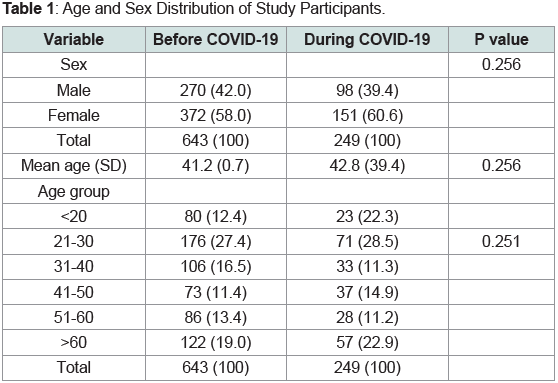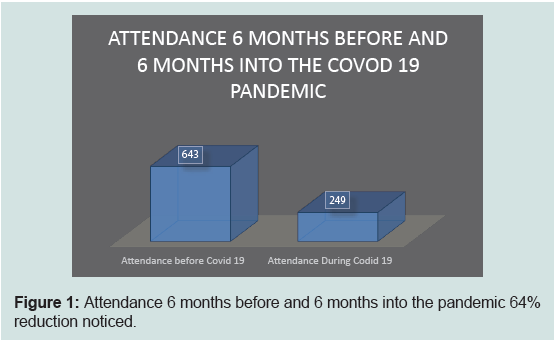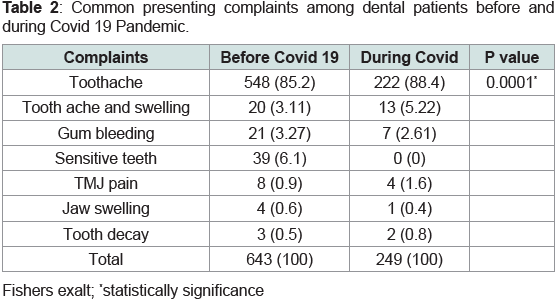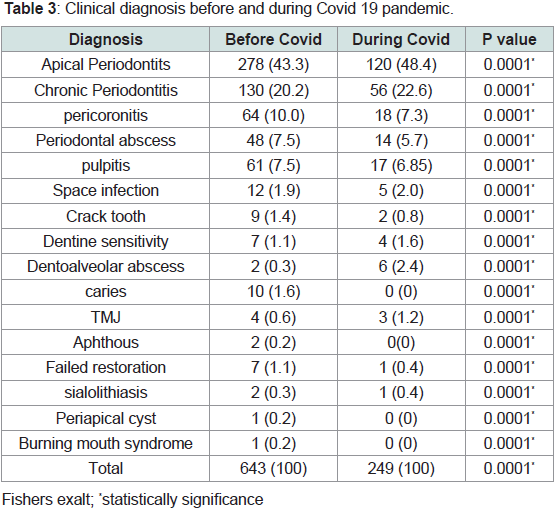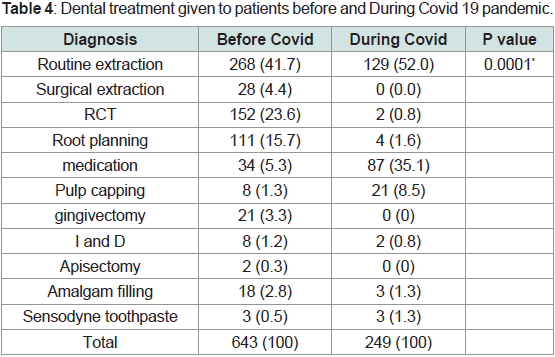Journal of Oral Biology
Download PDF
Research Article
Effect of COVID-19 Pandemic on Clinic Attendance and Management of Dental Patients: Our Experience at Dental Hospital, Obafemi Awolowo University Teaching Hospitals’ Complex, Ile Ife, Nigeria
Oyetola EO*, Oluwadaisi AM, Adewale AA, Adebayo OF and Adesina OM
Department of Oral medicine and Oral Pathology, Obafemi Awolowo
University, Ile Ife, Nigeria
*Address for Correspondence: Oyetola EO, Department of Oral
medicine and Oral Pathology, Obafemi Awolowo University, Ile Ife, Nigeria;
E-mail: Phemyhoye12@yahoo.com
Submission: 19-May-2022
Accepted: 28-June-2022
Published: 05-July-2022
Copyright: © 2022 Oyetola EO, et al. This is an open access article
distributed under the Creative Commons Attribution License, which
permits unrestricted use, distribution, and reproduction in any medium,
provided the original work is properly cited.
Keywords
COVID-19; Dental Patients
Abstract
Background: COVID-19 infection, declared pandemic by WHO
in January 2020 constituted a public health problem due to the highly
infectious nature of the disease and the subsequent lockdown imposed by
the government to control the spread. Dental services delivery was severely
affected.
Methodology: This is a retrospective study. Subjects were consecutive
patients who presented at the Dental Centre, Obafemi Awolowo University
Teaching Hospital Complex from August 2019 to August 2020. Patients’ data
was obtained from Oral Diagnosis Clinic records. Patients’ data obtained
include sociodemographics, complaints, diagnosis and treatment given.
Analysis was done using the STATA software package. Descriptive statistics
was done using frequency and percentages while bivariate analysis was
done using student test, p>0.05.
Results: A total of 892 patients (524, 58.7% females and 368, 41.3%
males) presented at the dental clinic during the study period. Their age was
41.6 (18.9) years and the majority of patients (882, 99.3%) presented on
account of orofacial pain. Significant reduction of dental clinic attendance was
found as 643 (72%) patients attended the clinic 6 months before pandemic
and only about one third, 229 (28%) patients attended the clinic 6 months
into the pandemic. Medications (72%), indirect pulp capping (73%) and oral
health counseling were the frequently adopted treatment protocols. Root
Canal Treatments (RCT) (1.2%) and surgical extractions were not frequent.
Conclusion: Only about one-third attendance was recorded at start of
Covid-19 pandemic in our centre. The management strategies at the critical
times involved more of medications, indirect pulp capping and counseling.
Introduction
Covid-19 disease is a condition caused by a novel strain of corona
virus called SARS-COV 2 [1]. The first sets of cases, initially described
as pneumonia cases of unknown cause in Wuhan City, Hubei
Province of China were first reported to WHO in December 2019 [2].
By January 2020, WHO declared Coronavirus disease, a Public Health
Emergency of International Concern (PHEIC) [1,2]. Globally, over
200 countries including Nigeria have experienced Covid 19 disease
outbreak [3]. The index case of Covid 19 infection in Nigeria was
confirmed in Lagos state on 27th February 2020. Ever since then, the
incidence of Covid 19 infection has been on the increase in Nigeria
and there has been a spread across states [2]. As at 12:14 am, 12th December 2020, 72,140 confirmed cases, 5,228 active cases, 65,722
discharged cases, and 1,190 deaths resulting from Covid-19 infection
have been reported by NCDC in Nigeria. (NCDC 2020)
The impact of Covid 19 pandemic on clinic attendance and
healthcare delivery cannot be overemphasized. The Commonwealth
fund on April 23, 2020 reported a 60% decline in the number of visits
to ambulatory care practices early in the pandemic [4]. Vollmer et
al also found a 35% reduction in emergency department at Imperial
college Healthcare, NHS trust, which was mainly amongst the elderly
(>65years of age) and those arriving by their own means either by
public or personal transport [5]. A 42% reduction in Non-COVID
related emergency admission was also noted after March 12 in this
study by Vollmer et al [5].
Healthcare delivery system in Nigeria as in other countries
experienced a reduction or halt of many clinical activities in order to
control COVID-19 transmission [6]. More so, the shortage of personal
protective equipment and ventilators as well as reported infection in
health care workers as a result of occupational exposures affected
the delivery of healthcare services [3,7]. A WHO survey involving
more than half of the countries showed 49% disruption in treatment
of diabetes and diabetes-related complications; 42% for cancer
treatment and 31% for cardiovascular emergencies [8]. Reassignment
of staff in most health care facilities to support COVID-19 outbreak
also contributed to the discontinuation of and reduction in delivery
of some health care services.
WHO country reports on COVID-19 shows that dental services
were not widely included as part of most countries’ COVID-19
preparedness and response plans [1]. Most dental procedures
require contact with oral fluids which poses the risk of COVID-19
transmission as the virus can be identified and detected in saliva. In
fact, the dentist was referred to as the most at risk healthcare worker
for contracting COVID-19 in an article published in New York Times
on the 15th of March 2020 [9]. The knowledge of the risk of COVID-19
transmission through inhalation of droplets and contact with saliva
has led to serious reduction and avoidance of some dental procedures
that generate aerosols and splatter in most dental facility. These
procedures include ultrasonic scaling, polishing with air polishers, tooth preparation for crown and bridges with dental hand pieces and
also tooth bleaching by air abrasion units. In order to reduce the risk
of COVID 19 transmission in the dental facility, the use of antiseptic
mouth rinse before oral examination and procedures; use of saliva
ejectors with a low or high volume, and strict adherence to personal
protective measures were recommended [11].
Considering the high risk of COVID-19 transmission with
treatment and its impact on dental services delivery, dental practice
was greatly affected as most patients. Many patients, for the fear of
contrasting the infection, preferred to abandon their dental care but
to later present with complications. This affected patients’ attendance
and subsequent dental services utilization. Data on the severity and
the subsequent pattern of this challenge in our environment has not
been documented in the scientific literature, and this is important to
foster comparison with findings from other countries. This study is
aimed at determining our local experience on the effect of COVID-19
pandemic on dental clinic attendance and dental patient management
at the time of occurrence of the pandemics.
Materials & Methods
This is a retrospective study of all patients who presented at
Dental Centre, Obafemi Awolowo University Teaching Hospital
Complex between August 2019 ( 6 month before declaration of Covid
19 infection as a pandemic disease by WHO ) and August 2020 ( 6
month after the declaration of Covid-19 infection as a pandemic
disease by WHO ).
Data was obtained from Oral Diagnosis Clinic records within
the study period. Sociodemographic characteristics of patients,
presenting complaints, diagnosis and treatment modalities of patients
who presented within the study period were recorded.
Analysis was done using the STATA 14 software package.
Continuous variable were presented as mean ± standard deviation
(SD). Categorical variables were presented as frequency and
percentage (n (%)) while bivariate analysis was done using student
t- test, after confirming the Normal distribution of the data with
appropriate test. The p value of <0.05 was taken as statistically
significant.
Results
Age and Sex Distribution of Study Participants: total of
643 participants (270 males and 372 females) visited dental hospital
6 months before Covid 19 pandemic while 249 (98 males and 151
females) patients presented 6 months into the pandemic period . The
mean age of participants who attended dental hospital during the
pandemic was higher than those who attended before the pandemic.
More than a quarter of patients that attended the hospital during
Covid 19 pandemic were in their second decade decade of life (Table 1,
Figure 1).
Common presenting complaints among dental patients before and during Covid 19 Pandemic: Toothache was the commonest reason for dental consultation
before and after the Covid 19 experience. The proportion of patients
with toothache, swelling and TMJ pain were higher during the pandemic Table 2.
Clinical diagnosis before and during Covid 19 pandemic: The percentage of patients presenting with apical periodontitis,
chronic periodontitis, space infection, dentine hypersensitivity and
TMJ pain was significantly increased during Covid 19 pandemic
while those presenting with dental caries, periapical cyst, and burning
mouth syndrome and aphthous ulcer was reduced to zero Table 3.
Dental treatment given to patients before and During Covid 19 pandemic: The frequent treatment given after the pandemic was routine
extraction and medications. Surgical extraction, RCT, root planing, gingivectomy and apicectomy were significantly reduced during
Covid-19 pandemic Table 4.
Discussion
The COVID-19 pandemic which has posed significant challenges
to every sector worldwide had a negative impact on patient attendance
at the Dental Centre of the Obafemi Awolowo University Teaching
Hospital Ile-Ife. A reduction in the number of patients and therefore,
common presenting complaints, the diagnosis of the same and
elective procedures were observed during the period in view.
Different studies including Alves et al and Watson et al reported
pandemic related reduction in patient volume [12,13]. While the
overall patients count reduction by 64% observed in this study was
in agreement with the finding by H. Guo et al [14]. it was higher
than the 38% reported in their study. This may be due to the fact that
only emergency services were considered by H. Guo et al. However,
University of Rochester Eastman Institute of oral health, who also
offered emergency dental services, reported over 2-fold or 85%
reduction in patients seen [15].
Whereas both elective and emergency dental services were available during the study period, more emergency services were
rendered; the aforementioned reduction can be attributed to a
number of factors. Restriction of movement and/or lockdown as a
a principal measure to curb the spread of the virus was paramount.
Access to the dental clinic was therefore difficult unless it was strictly
a need for emergency treatment. Opening days and working hours
were shortened to limit exposure of dental care givers to the virus
and as an additional barrier against spread of the virus in view of the
initial unavailability of personal protective equipment. The adverse
effect on the economy impacted on the population with dwindling
earnings and by extension purchasing power owing to widespread
business closure, especially in lower income populations such
as those obtained our locality [16]. Finally, the perceived risk of
getting exposed to the virus in the hospital setting might also have
discouraged patients from seeking dental care [17].
During the period in view, there was no significant difference
in the magnitude of the most common presenting complaint
(toothache), before and during the pandemic (85.2% and 88.4%
respectively). Toothache is a common clinical condition that often
presents as an emergency, thereby explaining the similarity of
observation. Temporomandibular joint related pain recorded a 0.7%
increase to 1.6% of complaints during the pandemic period compared
to pre-pandemic period as a result of increased stress and anxiety
arising from the uncertainties associated with the pandemic [18]. In
addition, psychological disturbances are identified risk factors for the
development of temporomandibular disorders [19]. Overall, pain
related conditions were commonly observed during the pandemic
probably due to their emergency nature.
Pulpal and periapical conditions were the most common diagnosis
before and during the COVID-19 pandemic with the attendant
symptom of pain associated with these conditions prompting clinic
attendance. This may also suggest a high restorative treatment need of
the population in which this study was conducted [20].
A reduction in invasive and aerosol generating procedures
was observed during the COVID-19 pandemic period as expected
in accordance with proposed safety protocols to reduce the risk of
exposure of dental health care workers to COVID-19 infection and
in compliance with guidelines for emergency treatment given by
the Federal Ministry of Health Nigeria Also noteworthy is a 7-fold
greater usage of prescription medications during the COVID-19
period (35.1%) compared to pre-pandemic period as palliative for
odontogenic pain as part of emergency service provision [21].
Within the limitations of this study, our results suggest that
the COVID-19 pandemic altered dental care seeking behavior of
individuals in need of elective dental treatment. Patient attendance
reduced by over one third during the COVID-19 period.
Conclusion
Patient attendance reduced to about one-third of prior attendance
before the COVID-19 pandemic period. The management of dental
lesions at this critical period involved less invasive procedures.


